This is, hands down, the best vegan pumpkin bread. It’s moist and tender, not too dense like many pumpkin breads, and is packed with a warming homemade pumpkin spice! It’s loved by tough critics and vegan skeptics, and unless you announce it ahead of time, no one will ever guess it’s vegan!
Plus, it’s so simple to make and no fancy baking equipment is needed. It’s adapted from my fan-favorite easy Vegan Banana Bread recipe, so you know it’s gonna be good!
Serve it plain for breakfast or afternoon snack. For dessert, dress it up with one of two icing options: a sweet and nutty maple tahini icing or a decadent cream cheese frosting!
Table of Contents
1. Why this recipe works
2. Ingredient notes
3. Step-by-step instructions
4. Tips for making this recipe
5. Frequently Asked Questions
6. YouTube recipe video
7. Recipe card
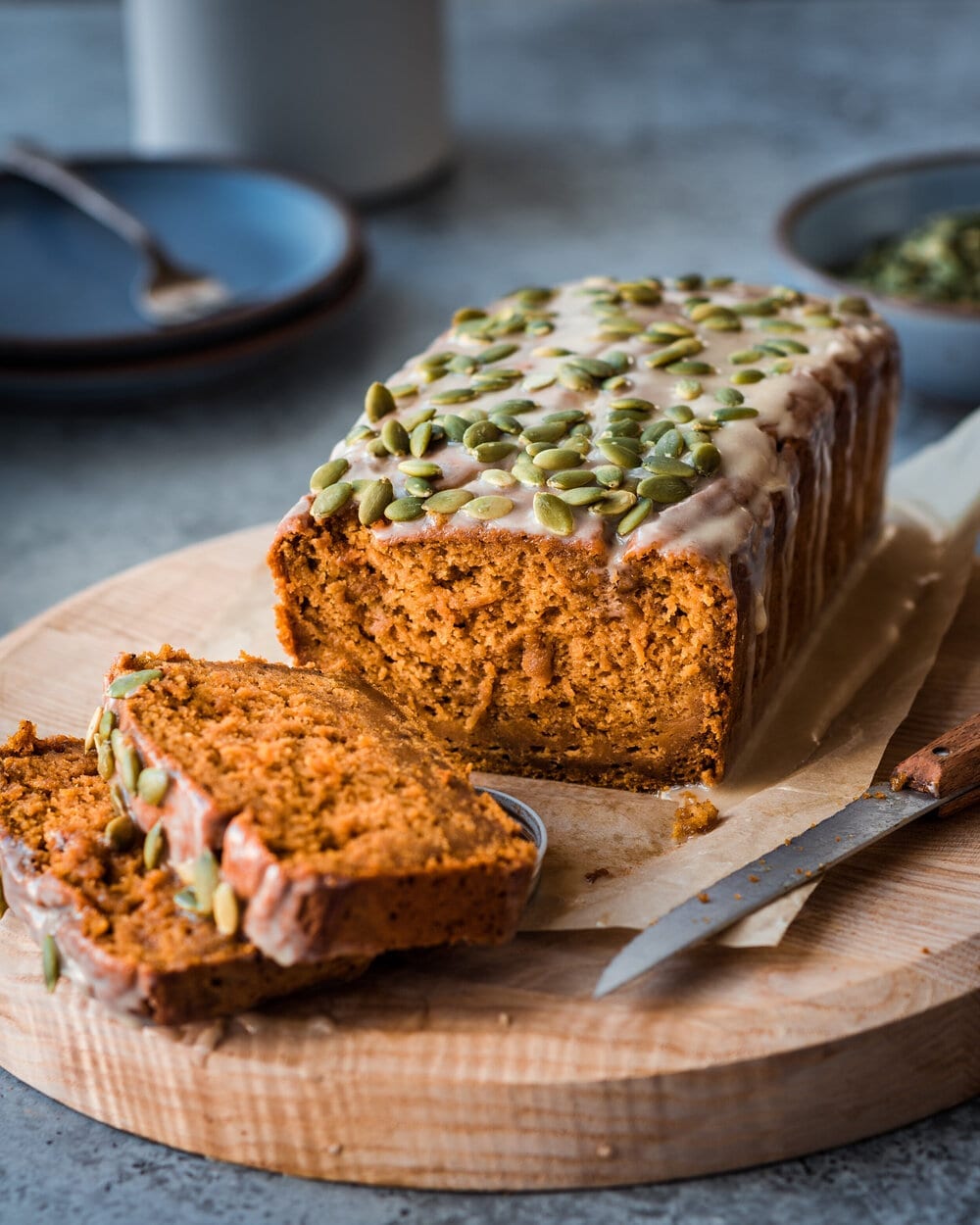
Why this recipe works
Not too dense or heavy
Pumpkin puree is itself very dense, and vegan loaf cakes are often too dense. As a result, most vegan pumpkin breads are too dense and heavy.
Despite the natural density of pumpkin bread, this pumpkin bread recipe is the most tender and moist variety I’ve tried, thanks to two ingredients: aquafaba and vegan buttermilk.
The type of vegan egg substitute used in baking use should depend on the type of baked good you’re making and your desired texture. With a cake, light and fluffy is always good. When you lightly whip aquafaba, it turns foamy. This, in turn, gives a nice lift to cakes and makes them fluffier.
While this pumpkin bread isn’t fluffy per se, it is significantly more tender than most.
As for the vegan “buttermilk,” its acidity—when combined with baking soda in the oven—enhances the amount of rise in the bread.
Real pumpkin spice and flavor
Many pumpkin desserts are lackluster because (1) not enough pumpkin spice is used and (2) a store-bought pumpkin spice blend is used.
This recipe calls for 4 teaspoons of a homemade pumpkin spice blend, so that pumpkin flavor really comes through.
Tip: Spices lose some of their potency shortly after being ground. As a result, any store-bought spice will be less flavorful than its freshly ground counterpart.
And when you combine several pre-ground spices into one pumpkin spice blend, the flavor will always be lackluster. Plus, there’s no way to tell how fresh the pre-ground spices were when the manufacturer bottled them into a pumpkin spice blend.
Plus, if you’re relying on last season’s pumpkin spice bottle in the back of the cupboard, the bread will lack that deep pumpkin flavor.
Takeaway: Make the homemade spice blend. It takes less than 5 minutes and is so worth it.
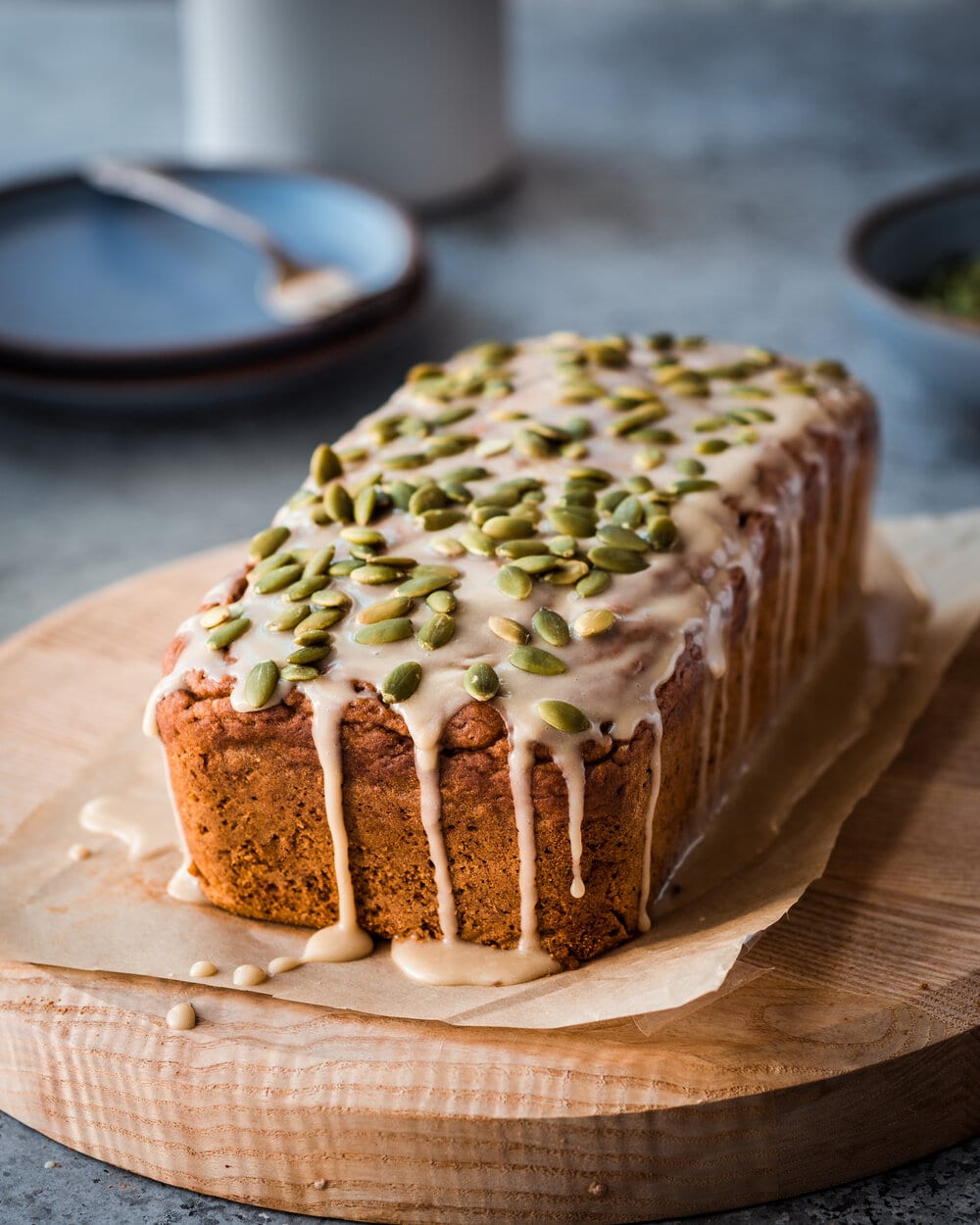
Ingredient Notes
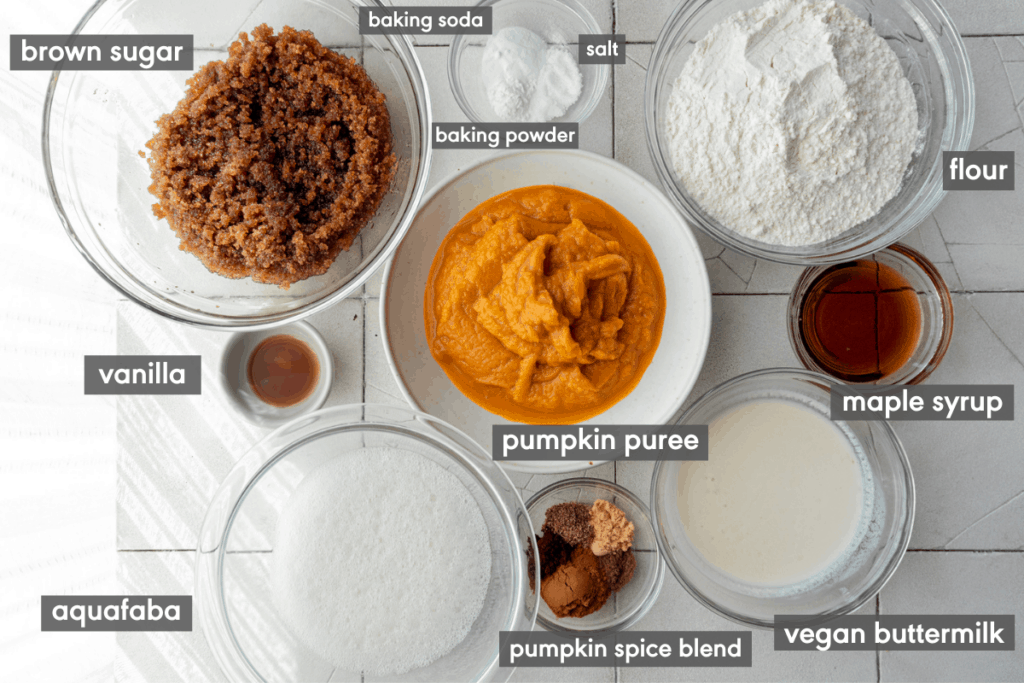
Vegan buttermilk. This is simple a mix of plant-based milk and a source of acid, like apple cider vinegar or lemon juice. I use oat milk for its superior browning capabilities in baking, though some readers have used soy milk successfully.
Aquafaba. Just the liquid from a can of chickpeas! If your can of chickpeas has salt added, scale back on the salt in the recipe a bit. It’s a crucial ingredient, so I recommend you don’t skipping or subbing it.
Canned pumpkin. A whole can for lots of serious pumpkin flavor. If canned pumpkin is not a thing where you leave, check out the FAQ section to see how to make this with whole pumpkin.
Homemade pumpkin spice: Freshly grated nutmeg adds a sweet, spicy zing and a generous amount of cloves brings a uniquely pungent, warming-sweet flavor.
Organic brown sugar: Adds more moisture and caramel-y flavor than cane sugar.
All-purpose flour. Necessary for structure. We have not had good results when using gluten-free flour, but you can try my gluten-free kabocha squash banana bread for a similar flavor profile.
Step-by-step instructions
In a medium bowl, whisk together the flour, baking powder, baking soda, salt, and homemade pumpkin spice.
In a large bowl, mix the brown sugar and oil using a hand mixer until well combined.


Add your lightly whipped aquafaba to the brown sugar mixture. Mix until the aquafaba is well incorporated.


Add in the pumpkin puree, maple syrup, vegan buttermilk, and vanilla. Mix again until smooth.
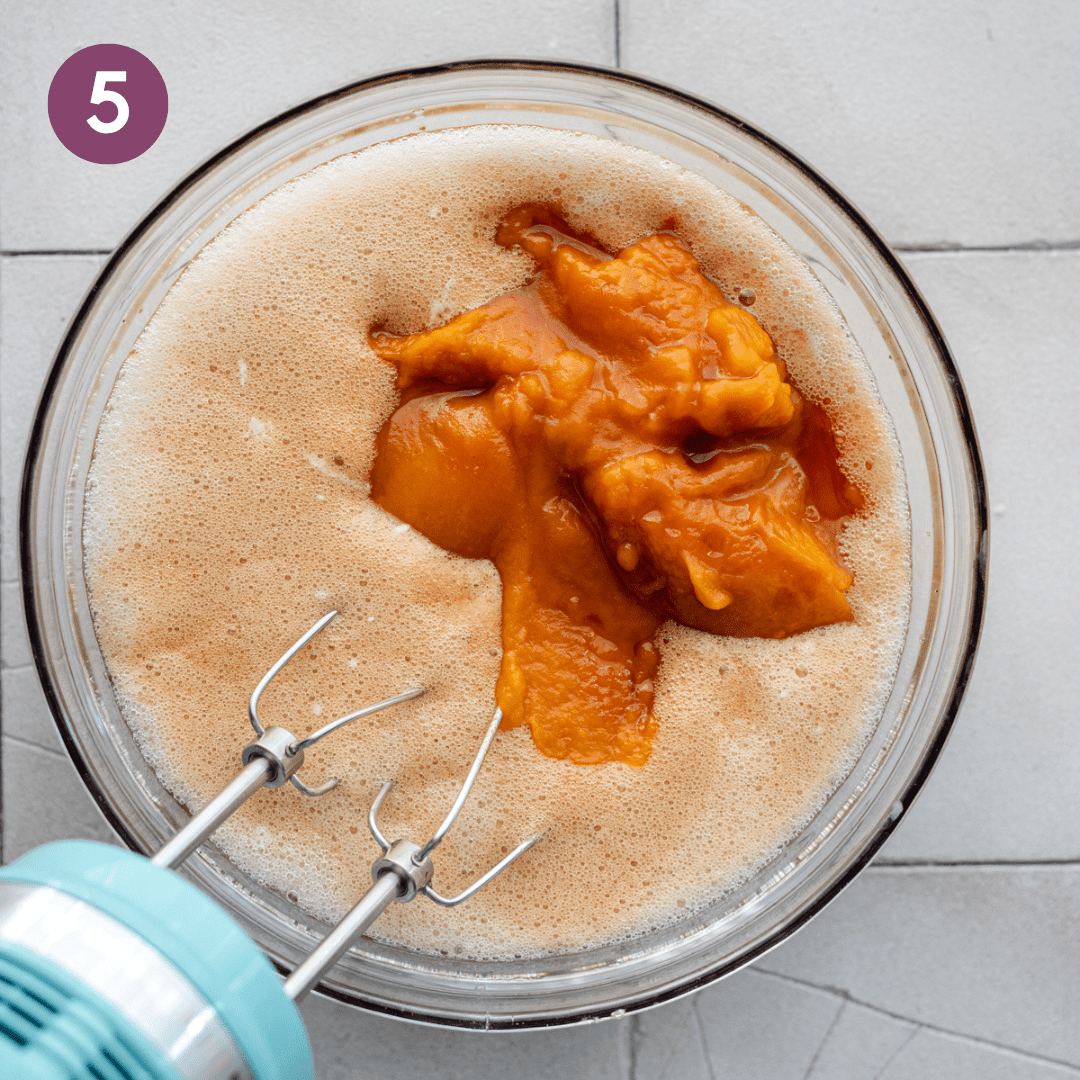
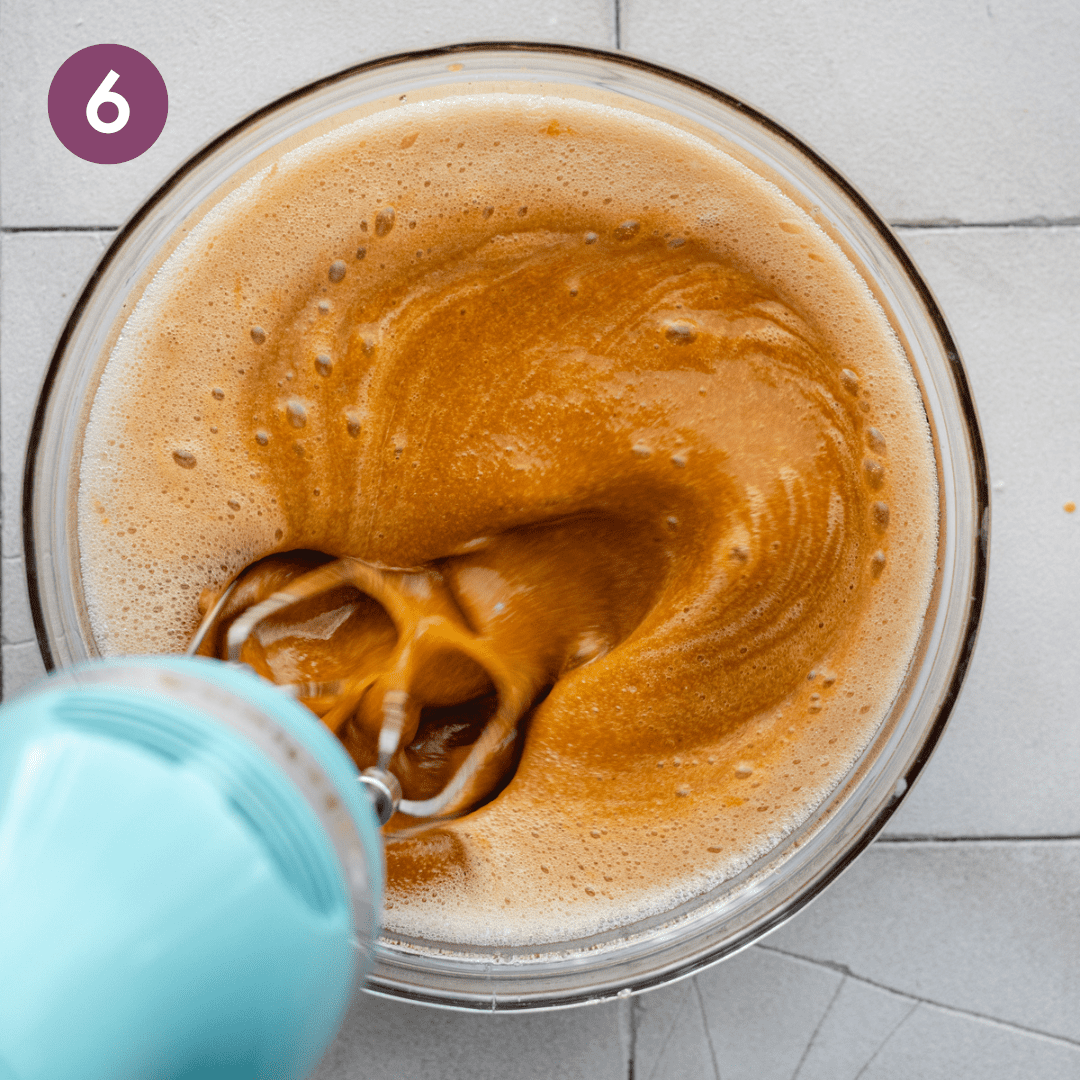
Add the dry ingredients to the wet ingredients. Use a silicone spatula to gently fold the ingredients into each other.


Mix just until the flour pockets are gone, then stop mixing. The batter should be somewhat lumpy and thick.
Pour the batter into a lined 9×5” (23×13 cm) loaf pan and smooth out the top with the spatula.


Bake at 350ºF/1765ºC for 55 to 60 minutes. Transfer to a wire rack for 10 minutes. Using the parchment paper handles, remove the bread from the pan and cool on the wire rack for 30 minutes before slicing.
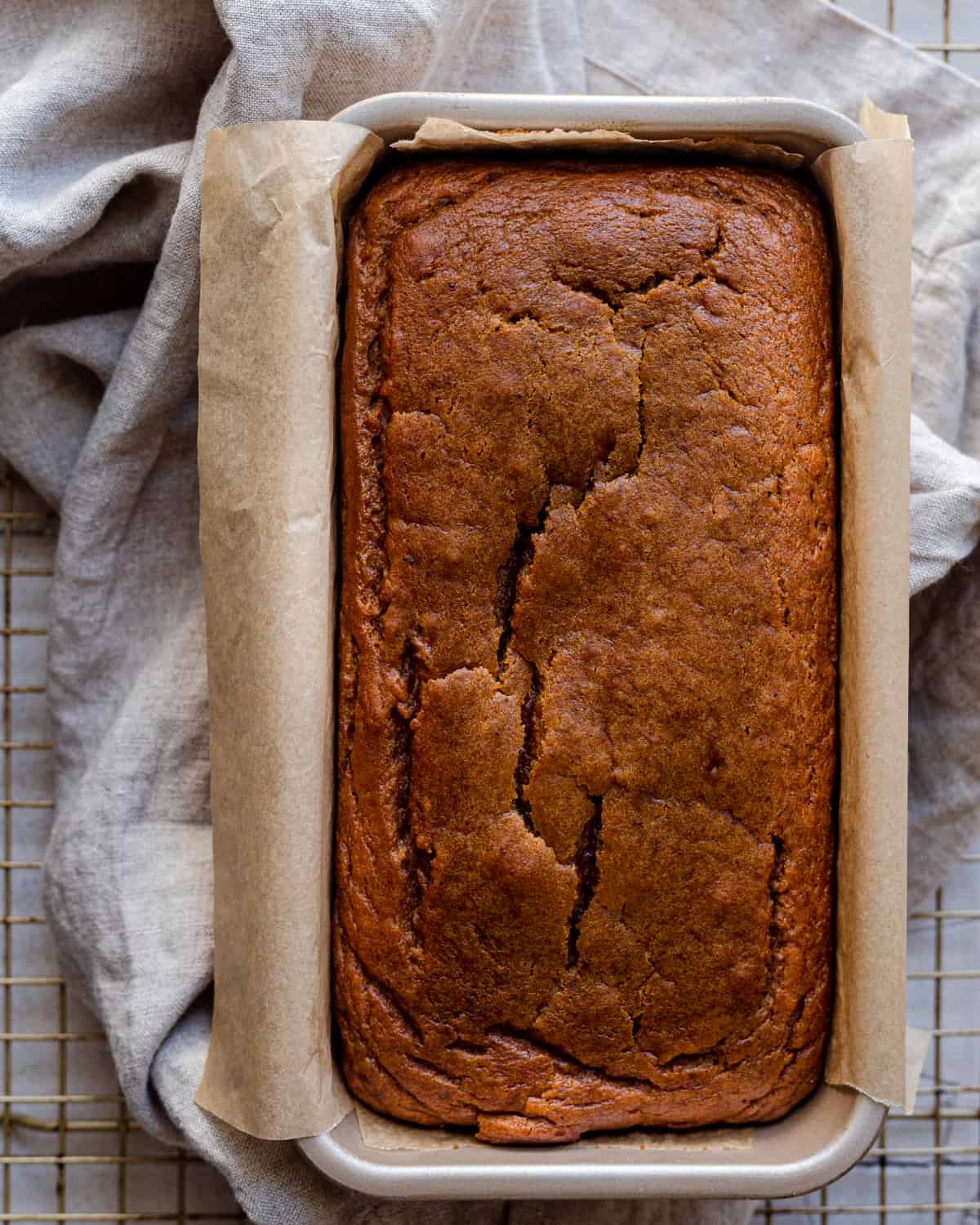
When ready to serve, drizzle with tahini icing (or serve on the side), or spread with the cream cheese frosting.
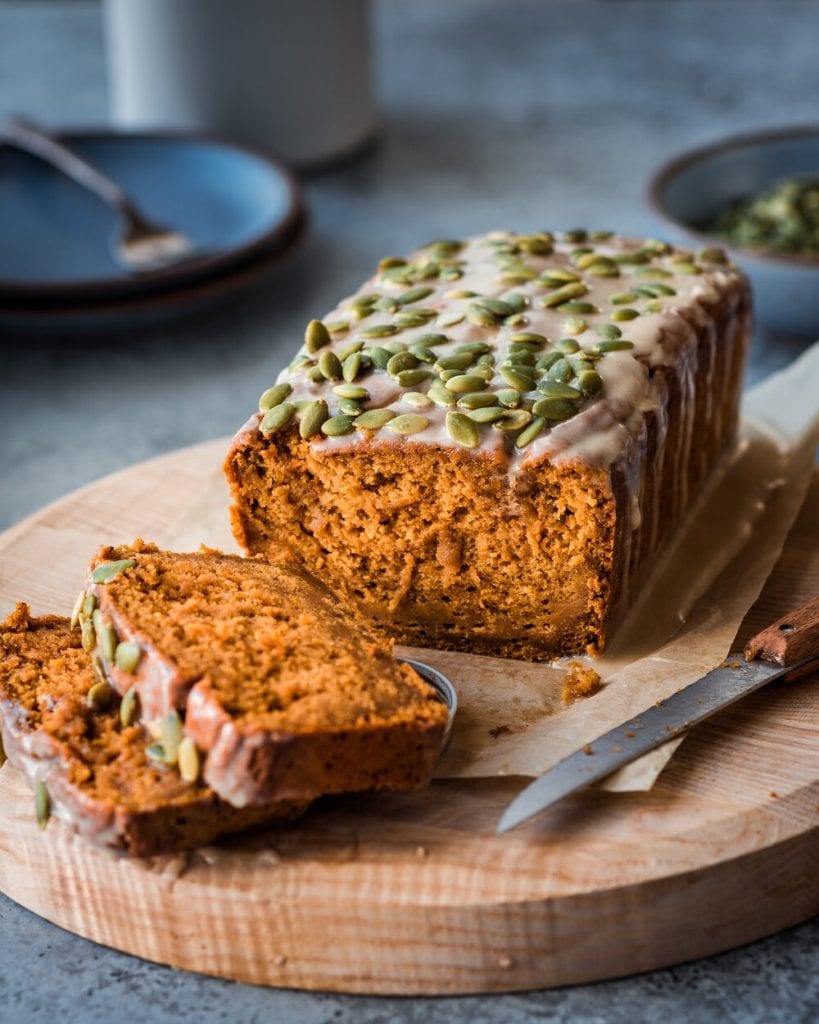
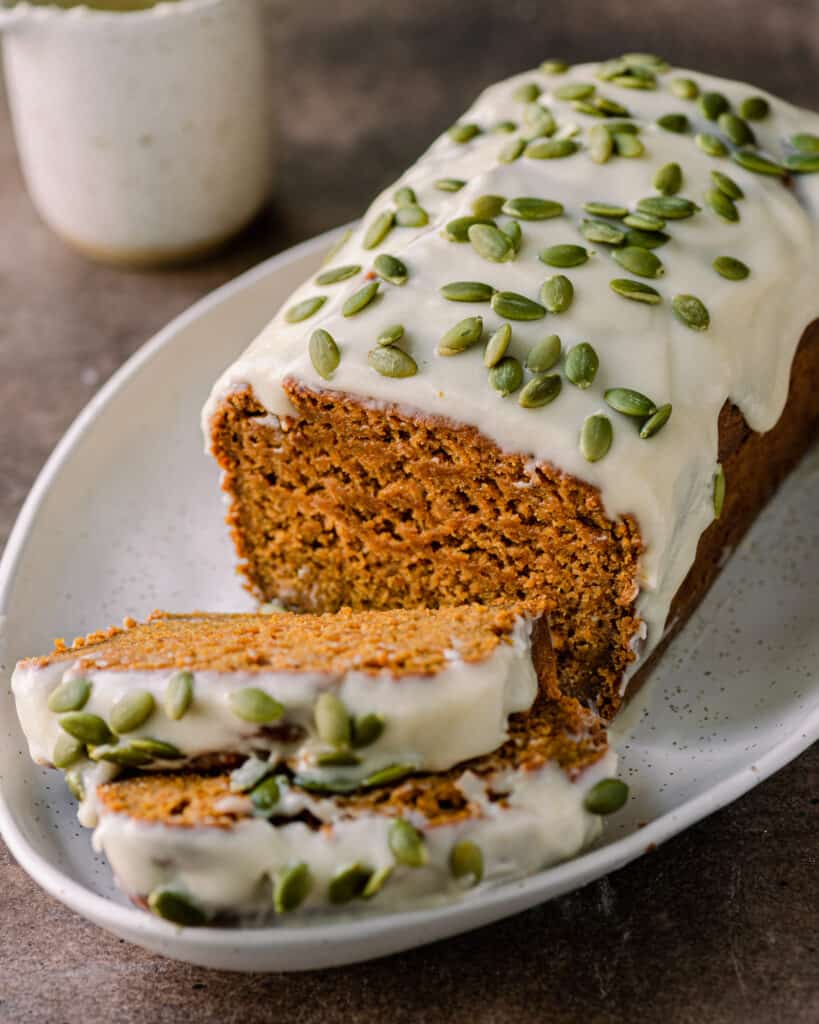
Tips for making vegan pumpkin bread
Opt for conventional canned pumpkin puree (not organic), if possible
I noticed a difference in canned pumpkin brands when making this recipe. When I used organic canned pumpkin puree instead of the conventional canned pumpkin from Libby’s, the pumpkin puree was more watery, resulting in a somewhat more liquid-y batter and a soggier bottom bread.
If you only have organic canned pumpkin, be sure to strain the pumpkin puree until all the excess water runs off.
Be Precise
- Use a digital scale. It yields the most exact results and baking is a science.
If you don’t have a digital scale, measure your flour using the spoon and level method. Spoon your flour out of the bag/jar into the measuring cup, spoon by spoon, until almost full, then use a butter knife to level it off. - Get an oven thermometer and allow adequate time to preheat. Every oven is different, and if yours isn’t calibrated, chances are it’s a bit off. Plus, most home ovens don’t reach the stated temperature when the preheat cycle is over.
- Use a toothpick for doneness. Insert a toothpick in the top sides of the cake at an angle, not straight down. This angled position is a much more reliable indicator of whether a tall loaf cake is baked through. See a few moist crumbs? The bread is done.
If the toothpick reveals batter that is still a bit gooey, return the pan to the oven for 5-10 more minutes. Worried about the top overbrowning? You can loosely tent the pan with aluminum foil.
No overmixing!
Overmixing is one of the most common baking mistakes, and it can cause the gluten to overdevelop, resulting in a cake that is dry and tough, or dense and gummy.
Once the wet and dry ingredients are just incorporated and flour pockets are gone, stop mixing. The batter doesn’t need to be (and shouldn’t be) smooth.
Know your pan size
I use a standard 9×5-inch loaf pan (23×13 cm), but if your pan is slightly smaller (e.g., 8×4-inch), there will be a small amount of excess batter. Don’t try to fit it all into the loaf pan, or it might rise too high and make a mess in your oven.
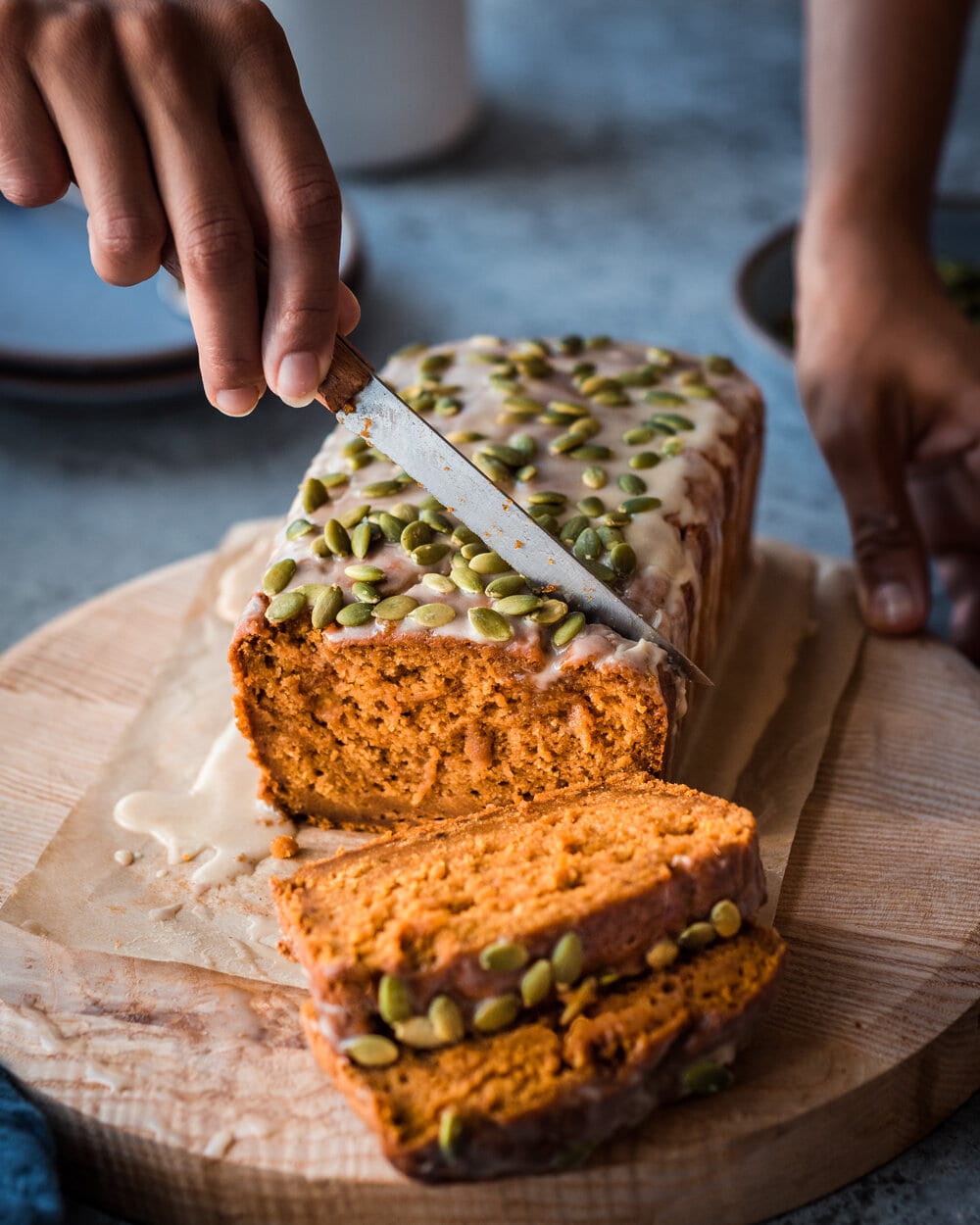
Frequently Asked Questions
Yes. Here’s how:
1. Slice a sugar pumpkin or pie pumpkin in half using a sharp knife and rocking motion (you can also use a kabocha squash). Don’t use the really large carving pumpkins – they are pretty flavorless and don’t have much flesh. If it’s too tough to slice, pop it in the microwave for 30 to 60 seconds.
2. Lightly salt the flesh of the pumpkin, then place the pumpkin halves on a parchment paper lined baking sheet, cut side down. Bake in the oven at 400°F/205°C until fork tender, about 30 minutes for a small pie pumpkin, or 40-45 minutes for a larger one.
3. Once the pumpkin is cool enough to handle, the skin should peel off easily. Add the flesh to a food processor and puree for about 2 minutes, or until you have a really smooth puree.
4. Place the puree over a fine mesh sieve and stir with a spoon to let any excess water drain out. If you have cheesecloth, line the sieve with that and drain. This step is essential since homemade puree is more watery than canned.
5. Finally, measure out the appropriate amount of pumpkin puree for this recipe: 425 grams, or about 2 tablespoons shy of 2 cups.
Aquafaba is one of the ways I keep this pumpkin bread light and tender, so I wouldn’t recommend substituting it.
If you want to eat this bread for breakfast or as an afternoon teatime snack, you can serve it plain! It’s a little sweet but not too sweet.
If you want something more dessert-like, there are two icing options!
First, the maple tahini icing, which was the original pairing for this recipe. The tahini brings a unique nutty flavor that pairs beautifully with the classic pumpkin spice flavors. Max said that this icing tastes like halva, a delightful Middle Eastern dessert made from tahini and sugar, and I’d have to agree with him. I recommend pouring the icing only on the amount of bread you plan to eat to prevent any sogginess.
Second, the vegan cream cheese icing. This is the more decadent option of the two and my recent favorite. The frosting is a bit tangy from the cream cheese and lemon juice and it perfectly balances the sweetness. When you refrigerate the bread, the icing sticks to it like a traditional frosting and it is SO good.
If unfrosted, store it covered or wrapped in plastic on the counter for up to 5 days. If you make the maple tahini icing, you can leave it at room temperature but it’s best to pour the icing only over the amount of bread you plan to eat that day (to prevent sogginess). If making the cream cheese icing, store the bread covered in the fridge for at least 5 days.
Watch! How to make The Best Vegan Pumpkin Bread
More delicious pumpkin treats
For more pumpkin treats, check out my Pumpkin Tart or my Pumpkin Pancakes.
And if you love this Vegan Pumpkin Bread recipe, please rate and review the recipe below :)
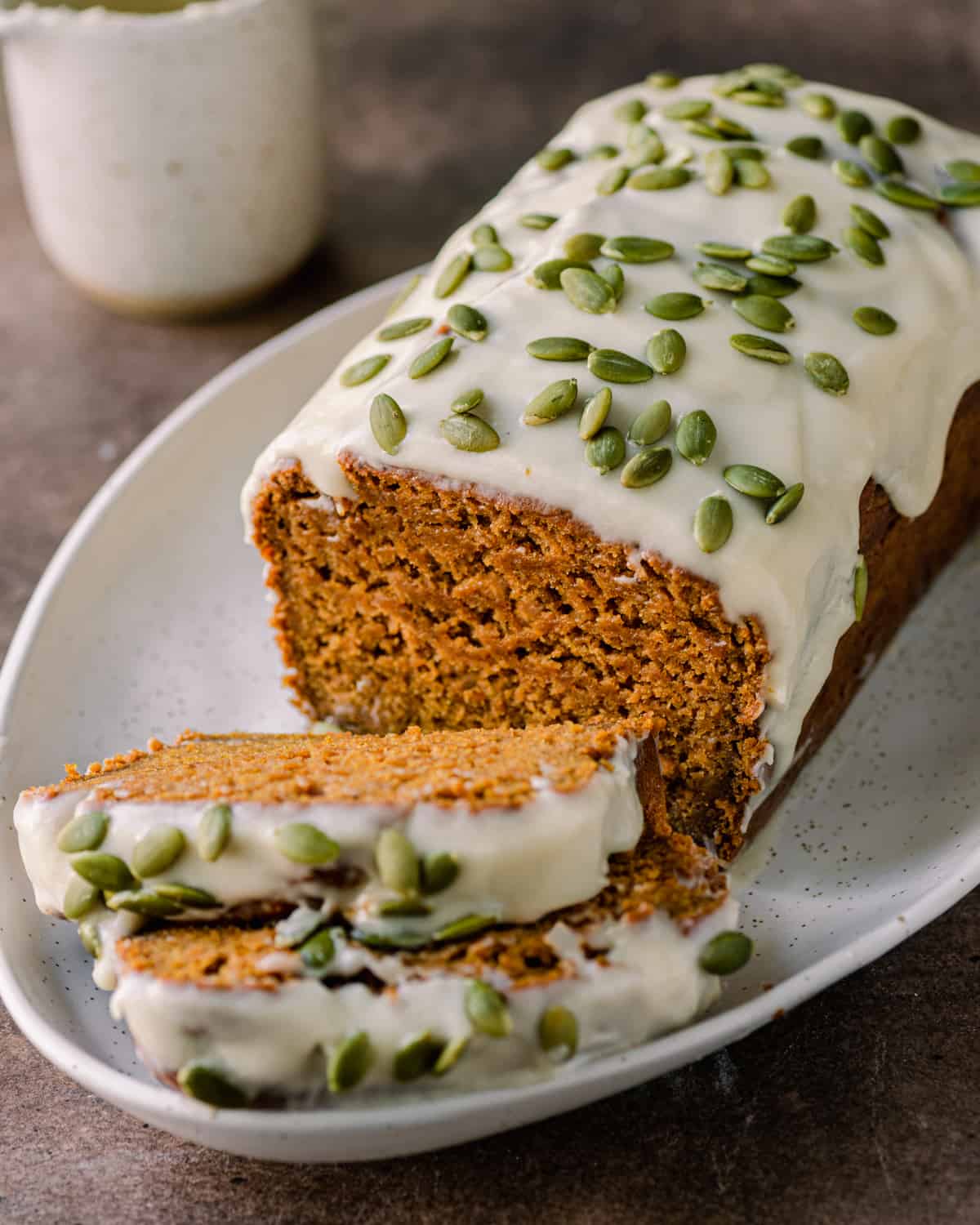
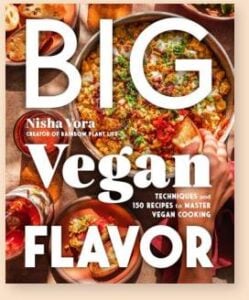
Big Vegan Flavor
Techniques and 150 recipes to master vegan cooking.
The Best Vegan Pumpkin Bread
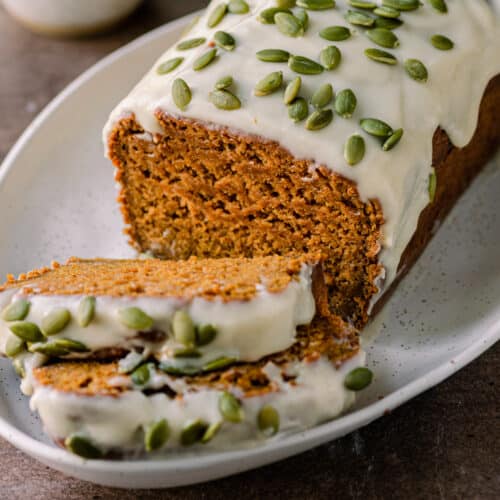
Ingredients
Pumpkin Bread Ingredients
- 1/4 cup + 2 TBSP (90 mL) aquafaba
- 1/4 cup (60 mL) oat milk, or unsweetened plant-based milk of choice
- 1 tablespoon apple cider vinegar
- 1/3 cup (75g) sunflower oil, or any neutral-flavored oil
- 1 cup + 2 TBSP (170g) organic brown sugar, loosely packed
- 1 15-ounce (425g) can pumpkin puree (I recommend not using organic canned pumpkin)*
- 2 tablespoons maple syrup
- 1 teaspoon pure vanilla extract
- 2 cups (250g) all-purpose flour, spooned and leveled
- 1 teaspoon baking soda
- 1/2 teaspoon baking powder
- 1/2 teaspoon fine sea salt
Homemade Pumpkin Spice
- 2 teaspoons ground cinnamon
- 3/4 teaspoon ground cloves
- 1/2 teaspoon ground ginger
- 1/4 teaspoon ground allspice
- 1/2 teaspoon freshly grated nutmeg
Frosting option 1: Cream Cheese Icing
- 4 tablespoons (56g) vegan butter, softened at room temperature
- 2 ounces (56g) vegan cream cheese**, softened at room temperature
- 1 cup + 2 TBSP (135g) organic powdered sugar, sifted
- 1/2 teaspoon pure vanilla extract
- Pinch of sea salt
- 1/2 tablespoon freshly squeezed lemon juice
Frosting option 2: Maple Tahini Icing
- 1 cup (120g) organic powdered sugar
- 2 tablespoons good-quality tahini***
- 3 tablespoons oat milk, or unsweetened plant-based milk of choice
- 1 teaspoon pure maple syrup
Instructions
- Preheat the oven to 350°F/176°C. Arrange a rack in the middle or bottom third of the oven. Line a 9×5-inch loaf pan (23×13 cm) with parchment paper, letting the excess hang over the long sides to form a sling.
- Stir the vinegar into the plant-based milk and set aside for a few minutes. This is the vegan “buttermilk.”
- Pour the aquafaba into a small bowl. Using a handheld electric mixer, whip the aquafaba on medium speed for 45 seconds, or until uniformly foamy.
- In a large mixing bowl, add the brown sugar and oil. Mix using the electric mixer or a whisk until well combined. Add the whipped aquafaba and mix until well incorporated. Add in the “buttermilk,” pumpkin puree, maple syrup, and vanilla. Mix until smooth and the ingredients are very well incorporated (this is important so you don't overmix 6).
- In a medium bowl, combine the flour, baking soda, baking powder, salt, and all of the pumpkin spices. Whisk well to ensure the leaveners and spices are evenly distributed.
- Using a silicone spatula or large wooden spoon, add the dry ingredients into the wet ingredients and gently stir until the ingredients are just barely combined and no flour pockets remain, then stop mixing! The batter doesn’t need to be (and shouldn’t be) smooth. Some lumps are normal. Note: the batter should be quite thick and almost fluffy at this point.
- Pour the batter into the prepared loaf pan and smooth out the top of the batter using a spatula or spoon.
- Bake in the preheated oven for 55 to 60 minutes, or until a toothpick inserted into the top sides of the cake comes out mostly clean with just a few moist crumbs.I like to check the bread at 53-55 minute mark. To test if it's done, insert a toothpick downwards at an angle (not just straight down). If the toothpick reveals batter that is still a bit gooey, return the pan to the oven for 5-10 more minutes. If you’re worried about the top overbrowning, loosely tent the pan aluminum foil.
- Transfer the pan to a wire rack and cool for 10-15 minutes. Then, using the parchment paper handles, remove the bread from the pan and cool on the rack for at least 30 minutes before serving. Serve plain, or with the Cream Cheese Icing or the Maple Tahini Icing and scatter with handful of pepitas or chopped pistachios. If using Maple Tahini Icing, pour it only on the amount of bread you plan to eat (or serve it on the side).****
Cream Cheese Icing (optional)
- To a medium mixing bowl, add the softened vegan butter. Beat on low speed with an electric hand mixer until smooth. Add the cream cheese and beat until well incorporated and creamy. Add half of the powdered sugar, mix on low speed to combine, and then add the rest of the sugar. Mix until well combined and fluffy, scraping down the sides as you go. Add the vanilla, salt, and lemon juice and mix until smooth. If too thick, add a splash of plant-based milk. If too thin, briefly refrigerate.
Maple Tahini Icing (optional)
- Sift the powdered sugar into a large bowl (sifting gets rid of the lumps in the sugar). Add in the tahini, milk, and maple syrup. Whisk to combine until the icing is thick but pourable. If too thin, add more sugar. If too thick, add more milk.
Notes
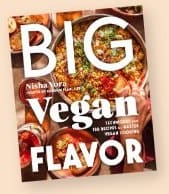




This is the best and more delicious moist pumpkin bread I have ever done. Thank you!
Dear Nisha & Team,
The pumpkin bread is delicious. Perfectly moist and holds together beautifully. But the sweetness is overwhelming. Is it possible to use a lot less sugar? If yes, how much would you suggest to use next time I make it (because there will definitely be a next time, it’s really good)!
Cheers :)
Found the answer in another comment, sorry. I made the cake without icing and already used one cup of sugar. I know that sugar contributes to the texture etc., so I will try 1/2 cup of sugar next time.
Hi there, so happy you enjoyed the pumpkin bread! Did you make it with one of the frostings or icings? If yes, I would simply omit that as a first step. You can probably omit the 2 tablespoons maple syrup and 2 tablespoons of the brown sugar without changing the texture too much. Hope that helps!
Deliciously moist, excellent spice balance. I have to disclose that I am not vegan, so I take a few liberties using non-vegan options that I have on hand when I don’t feel it will significantly change the taste or texture. In this case I used cow’s milk instead or plant-based. Otherwise, the recipe was executed as written. So good!
We’re happy to hear you had success with the pumpkin bread, Marilyn! Thanks for sharing!
I always absolutely love RPL recipes but this one did not work for me. I made it the first time using organic pumpkin and it did not turn out. Completely my fault as the recipe suggests against using organic pumpkin. So I made it again with non organic pumpkin but it turned out almost the same as the first time. I followed the recipe exactly even weighing my ingredients. I cooked it for a couple minutes longer than suggested but even still the bottom will not cook / rise. Flavor is good but texture is really off. Don’t know what I’m doing wrong, disappointed.
Hi Mckayla, we’re sorry to hear about that! There are several issues that could have caused the pumpkin bread to not rise or cook through.
First, do you have an oven thermometer? Most home ovens are not that accurate (unless they’ve been calibrated). It’s possible your oven is a bit cooler than stated, which would explain why it took longer than expected.
Second, it’s important when baking to not open the oven door (except when close to the end to check on doneness). Opening the oven door even for 10 seconds can dramatically drop the temperature of the oven. You want to particularly avoid this in the earlier part of baking, as i will interfere with the ability of cakes/quick breads/muffins to rise.
Third, it’s possible that your baking powder and/or baking soda are no longer fresh. These agents are responsible for baked goods rising, so if either is past its prime, it will contribute to the pumpkin bread not rising and instead staying uncooked in the middle.
Finally, it’s important to be gentle when folding the wet and dry ingredients together. Overmixing and trying to get a super smooth batter leads to excessive gluten development in the flour, resulting in a denser and more sunken texture.
We hope this answer helps you troubleshoot!
I rarely leave ratings on recipes, but I had to say this turned out spectacular! Really satisfied the pumpkin craving, and the tip to make your own pumpkin spice was absolutely essential. So moist, fluffy and bright, will be making this again!
Hi Shelle, thank you so much for taking the time to leave a review! I just made this again myself, and it truly is such a wonderful recipe!
Thank you for the recipe!
I have used it many times already and always a great success.
Today I’ve baked in form of muffins.
As the pumkin was quite sweet- I halved the amount of sugar, and still they are delicious.
Thank you soooo much for everything you do, dear Nisha🙏
We appreciate your feedback and support, Eve. Thank you for leaving a review!
Hi Nisha,
I really wanted to make this cake on my gluten-free diet, despite the suggestion not to use anything else but all-purpose flour. So I proceeded with some substitutions: Bob’s Red Mill Gluten Free 1-to-1 Baking Flour, homemade honeynut squash puree, 130 g of light brown sugar, and olive oil. Even though the outcome is less fluffy than in your photos, I think the flavor is delightful and the bread rose nicely, although it did collapse a tad after a night’s rest on the counter.
Thank you for creating this recipe (and tons of others!)
Karolina
Hi Karolina, we’re glad you enjoyed your GF rendition of this pumpkin bread along with the other recipes that you’ve tried :) Thanks for sharing your experience!
Hi Nisha! Can we play with the amount of sugar and decrease it a little bit? We don’t use much sugar on our house with the kids and would like to make this as a treat but use less sugar.
We are at excited to try your October recipes!
Hi Shama, I would first omit the icing / frosting instead of omitting it from the actual pumpkin bread. That way, you don’t interfere with the baking texture (sugar not only adds sweetness in baking but also contributes to texture and moisture levels). If you still want to reduce the sugar in the bread itself, I’d reduce it by no more than ¼ cup.
Enjoy the recipes! :)